
“He who makes a beast of himself gets rid of the pain of being a man.”
-Samuel Johnson
Though the muscle-up is most commonly known as a gymnastics exercise, it is also one of the most intense calisthenics moves out there. Gymnasts don’t actually get points for muscle-ups, but they must do one in order to get in position to begin their routine. That’s right - for a gymnast, a muscle-up isn’t even a real move! That’s not a statement against the muscle-up, however. It is a testament to the level of elite gymnastic competitions. After all, a gymnast would look pretty silly if they just started busting out pull-ups during their routine, but that doesn’t mean the pull-up ain’t an amazing exercise!
The first time I tried to do a muscle-up, I was already quite good at pull-ups, so I expected to be able to do it right away. Needless to say, it didn’t happen quite that easily. Like anyone else, I had to practice a lot to get the timing right. Getting a feel for the movement pattern takes practice, even if you’re already strong. The muscle-up is a very unique skill that can single-handedly build serious strength and sculpt a powerful upper body. The only catch is that you already have to be strong in order to do that first one.
No other exercise requires both pulling and pushing power quite like the muscle-up, but it is also one of the most demanding abs exercises as well. You get a lot of bang for your buck with this one. The muscle-up is truly the ultimate upper body exercise.
In the beginning of this book I told you the only bar exercises were pull-ups, dips and hanging leg raises, and everything else is just a variation or combination of those things. Some people mistakenly think the muscle-up is just a combination of a pull-up and a dip, but in reality a muscle-up is closer to being a combination of all three. The pull-up and dip part should be obvious, but you must also squeeze your abs tight and move your legs away from your body to get around the bar, just like when performing a hanging leg raise.

To practice muscle-ups, you’ll need a bar with plenty of overhead clearance. Ironically, many high-tech gyms lack a simple straight bar. Watch out for universal machines with all those fancy ergonomic handles - they’re lousy for muscle-up training. You’re probably better off not going to a gym anyway. It shouldn’t be too hard to find a local park with a suitable bar. After all, when was the last time you saw someone do a muscle-up at a gym?
When you do a muscle-up, instead of simply trying to pull your chin past the bar, the objective is to pull (and then push) your entire upper body up and over. If you’ve never done this move before, get ready for a humbling. Even if you can do lots of pull-ups and dips, you’ll still need some practice on the transition before you will be able to execute a proper muscle-up.
As I mentioned in chapter four, kipping pull-ups and plyo-pull-ups are a fantastic precursor to the muscle-up. It can also be helpful to practice explosive pull-ups with an exaggerated range of motion. Instead of stopping when the bar is below your chin, pull that sucker all the way down past your chest. Get as far over the bar as you can!
Though there is no set rule for how many reps are needed as a prerequisite, I recommend getting well into double digits on both pull-ups and straight bar dips before attempting the muscle-up. But remember that proficiency in these moves doesn’t guarantee you success. While some people who can only manage six or seven pull-ups can muster up a muscle-up, others who can bang out twenty dead hang pull-ups still continually fail at getting through the sticking point. The muscle-up is a unique challenge and must be treated as such.
When starting out, it can be helpful to practice a modified muscle-up on a bar that is about chest height so you can use your legs to help jump into it. (If you can’t find a low bar, bring a step or a bench up to a high bar.) This will let you get a feel for the transition from being under the bar to getting on top without having to overcome the resistance of your full bodyweight. With practice, you’ll learn to rely on your legs less and do most of the work with your upper body.

Get as far over the bar as you can!
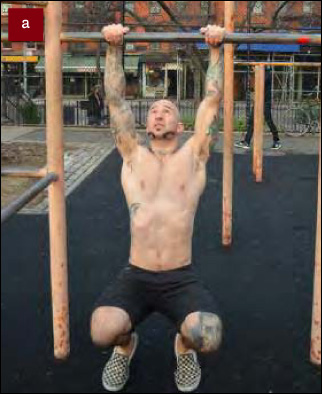
When starting out, It can be helpful to practice a modified muscle-up on a bar that is about chest height so you can use your legs to help jump into it.
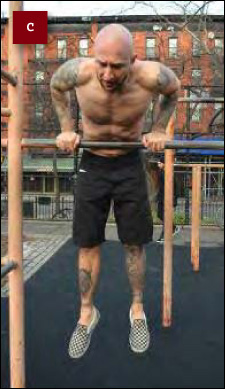
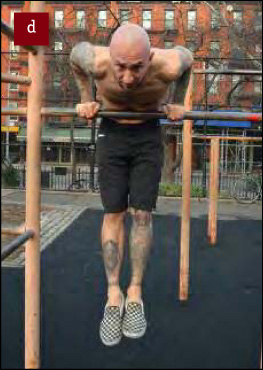
Some people will find it helpful to use a false grip when performing a muscle-up on a bar. The false grip in an exaggerated hook grip that entails bending your wrists over the bar so that your palms are facing down toward the ground. The false grip can allow for an easier transition between the pull-up and dip phases of the muscle-up.

The false grip can allow for an easier transition between the pull-up and dip phases of the muscle-up.
Just like when you are working on getting your first pull-up, it can be helpful to practice negatives and use manual assistance while learning to do a muscle-up. If you are going to spot someone on a muscle-up, I suggest giving them a boost by holding them under one or both heels, as if you were helping them over a fence.
Another technique that can be helpful when starting out is to practice from the top down. Perform a rollover (or find some other way to get to the top of the muscle-up position), then try to create momentum by dropping down. Use that downward momentum to propel yourself back up into your muscle-up. Imagine that your body is a rubber band being stretched out. Remember what happens to that rubber band when you stretch it out and then let it go.
Speaking of which, remember that “S” shape we talked about for kipping pull-ups? When you perform a muscle-up, you will again need to utilize the S-shape movement as your body moves around the bar. You do not go up in a straight line.
Since the range of motion for a muscle-up is much larger than that of a pull-up, you are going to have to do a larger “S” to get yourself over the bar. Exaggerating this “S” shape can allow you to get better leverage and momentum, so use it to your advantage, especially when learning the movement pattern.
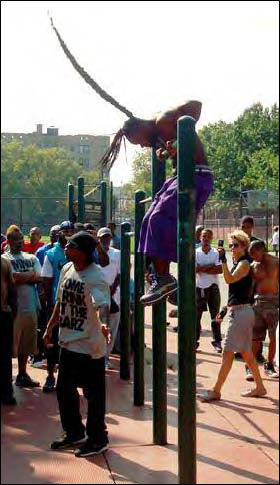
Note the “S” shape movement pattern.
No one’s first muscle-up looks great. In the beginning you’ll probably need to squirm your way through the sticking point and you’ll likely wind up with one arm going over the bar before the other. It’s also common for beginners to bend their knees and kick a lot from the legs. While this is not ideal, it is okay as long as you don’t let it become a habit. Once you can do a few reps, work on cleaning up your form. Eventually you should be able to do muscle-ups with your legs straight and minimal hip movement. There is always more room for growth in your training.

Beginners often need to get one arm over the bar before the other.
Though it may take you weeks, months or possibly longer to get your first decent muscle-up, once you get comfortable with muscle-ups, you will eventually be ready to move onto harder variations.
Just like pull-ups, muscle-ups are typically done with the hands just outside shoulder width, but they can also be done wider or narrower for an extra challenge. The close-grip muscle-up is a particularly challenging move. Work on gradually bringing your hands closer together over time, eventually building to the point where they are touching.

Work on gradually bringing your hands closer together over time, eventually building to the point where they are touching.
Once you’ve gotten a feel for kipping into a muscle-up, performing a slow muscle-up is a worthwhile challenge. After you can perform six or seven kipping muscle-ups, you should be ready to go for it.
As I mentioned before, I sometimes use a false grip for muscle-ups, but there’s actually a special false grip that I like for slow muscle-ups. For this variation I like to have my closed fist resting on top of the bar with the bar in the crook of my wrist. This really cooks my forearms, but it allows for better leverage when aiming to keep the movement slow.

I sometimes use a false grip for muscle-ups, but there’s actually a special false grip that I like for slow muscle-ups.
When you do a slow muscle-up, you’ll really need to reach your legs away from your body during the transition phase in order to counter balance your weight behind the bar. The carryover from hanging leg raises can make a big difference here but it still takes a lot of practice. It is also another instance in which practicing slow negatives can be helpful.
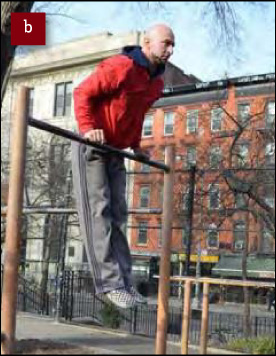
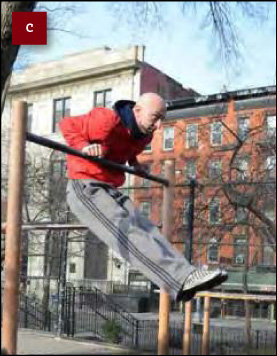
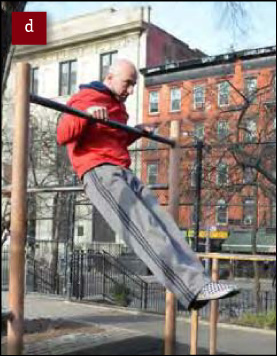
Here we see a slow muscle-up negative with the exaggerated false grip.
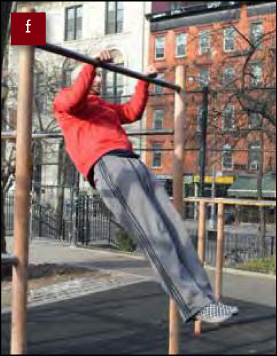
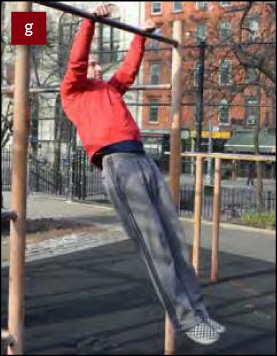
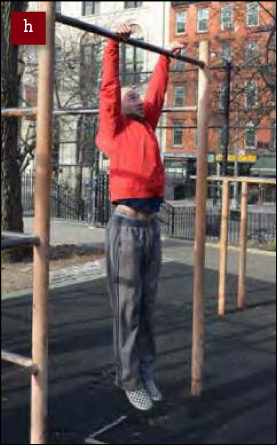
Performing a muscle-up on parallel bars requires monstrous grip strength as well as total body control. If you’re going to try this move, get comfortable with a slow muscle-up on the high bar first, then take some time to get a feel for hanging off the end of the parallel bars. You’ll have to use a false grip with the end of the bars against your forearms. You’ll also need to tuck your legs or do an L-hold to keep your feet off the floor. Those two things alone can require some practice. After that, start working on pull-ups from this position. Soon you’ll be ready to muscle-up all the way to the top. When you go for a muscle-up between parallel bars remember that your chest can pitch forward between your hands, almost more like a muscle-up on rings than one on a bar.
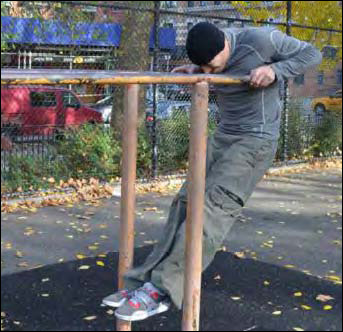
A muscle-up on parallel bars is similar to a muscle-up on rings.
If you do enough muscle-ups, eventually you can try to push beyond the normal range of motion and propel yourself completely off the bar. Once you’re in the air, you may choose to toss in a clap or other freestyle movement of your choosing. When practicing plyo muscle-ups, you can use your hips to “cast off” the bar for more height.
When practicing plyo muscle-ups, you can use your hips to “cast off” the bar for more height.
A muscle-over takes the plyo muscle-up to the next level. Instead of just getting a little hang time at the top, a muscle-over involves throwing your entire body over the bar. Remember to bounce your hips off the bar to get a little extra momentum. Psychologically, the muscle-over can be quite intimidating at first, but if you really want this move, don’t let your fear stop you from trying! If you can do a muscle-up and a vault, you can do a muscle-over. You may find it helpful to rest your outside foot on the bar as you go over to spot yourself as you get more comfortable with the maneuver.

Start by spotting yourself with your foot.
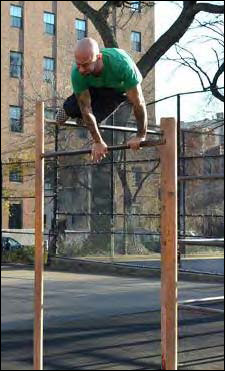
Eventually you’ll build the confidence to vault right over.
This is a variation on the muscle-over than involves landing on top of the bar instead of jumping completely over it. It’s a cool looking freestyle move that takes balance and bravery! Try this one at your own risk!

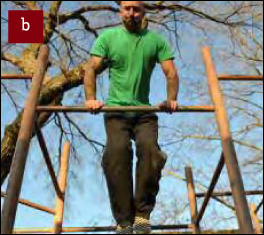
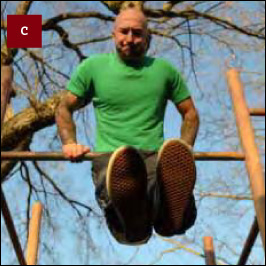
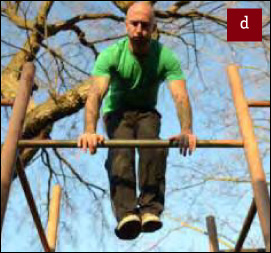

Try this one at your own risk!
Performing a muscle-up with one hand under and one hand over is harder than it may seem. Creating a smooth transition from under the bar to being on top is quite challenging in this position, as the underhand side will have a hard time rolling over the bar. Consequently, the overhand side needs to do most of the work. At first, you may find yourself wiggling a bit through the transition as you find a way to work your supinated hand over and around. Keep practicing!

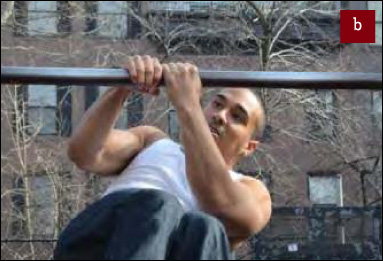
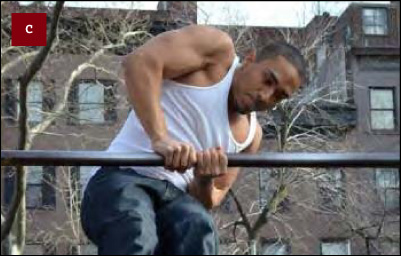
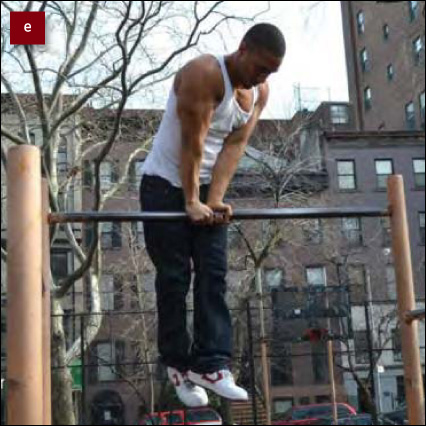
Creating a smooth transition from under the bar to being on top is quite challenging in this position, as the underhand side will have a hard time rolling over the bar.
Unlike the pull-up, which is typically easier with an underhand grip, performing a muscle-up with your palms facing towards you is much harder than with your palms facing away. In order to perform a reverse grip muscle-up, you need to generate a lot of explosive power by kipping from your hips and creating a large arc with your body as it moves over the bar. Since you can’t use a false grip when your palms are facing you, allow your palms to spin around the bar on the way up. Be careful with this move, as it can place a lot of strain on your thumbs during the transition. At first, you may need to rest your chest on the bar in order to bring your hands around.
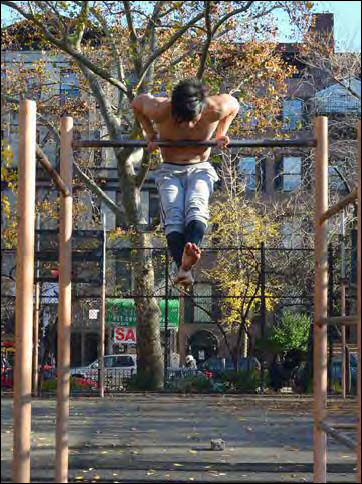
You may need to rest your chest on the bar during the transition in an underhand muscle-up.
As the name implies, this variation involves crossing your arms like an X, with each hand over the opposite side’s shoulder. When you do an X muscle-up, the arm that is on the bottom has to do most of the work, so start by learning with your dominant side underneath. It took me lots of practice to get the hang of these and I still need to work on cleaning up my form. Even if you are very good at muscle-ups, you’re unlikely to get this one on your first try.

The switch grip or “switchblade” muscle-up is one of the more difficult plyometric variations. To perform the switchblade, start out hanging below the bar in an underhand (chin-up) grip. From here, pull yourself up explosively, reversing your grip during the transition phase. You’ll have to generate lots of explosive force to get high enough over the bar to catch yourself and push through the dip phase to complete the exercise.
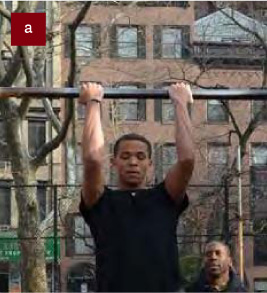
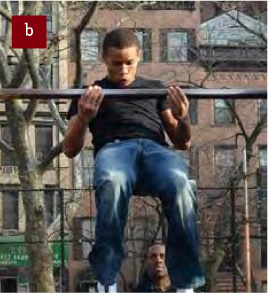

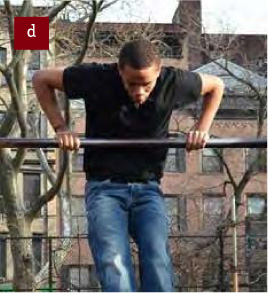
You’ll have to generate lots of explosive force to get high enough over the bar to catch yourself and push through the dip phase to complete the exercise.
This move involves releasing the bar at the top of the muscle-up and rotating your entire body in a full 360 degree spin before grabbing the bar on the way down. Moves like the 360 muscle-up look really bad-ass but like a lot of the freestyle variations, they aren’t necessary for someone who’s simply looking to get strong and fit. With increased difficulty sometimes comes increased risk. (I’ll come back to this idea later.)
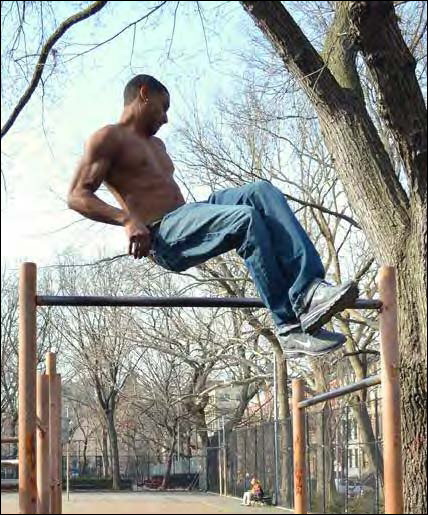
While most people (myself included) may never even be close to performing a one arm muscle-up, it is within the spectrum of human possibility. One need look no further than a simple YouTube search for evidence of this. While a few chosen ones might be able to eventually conquer this move, for the rest of us, it should serve to keep us humble and motivated. I mean, if there’s someone out there who can do a muscle-up with just one arm, shouldn’t any able bodied two armed-man be able to get at least a couple of reps with both?
